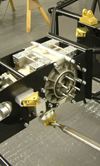Trends in Race Clutch Design
 The traditional race car multi plate clutch is essentially a friction drive that transmits engine torque into the transmission itself. Layers of plates are alternately geared to the clutch housing, which is bolted to the engine flywheel and also to the clutch hub, which is splined to the gearbox input shaft. When a heavy axial, or clamp load is applied to the assembly, the friction produced between plates prevents any rotation between them and we have a solid drive without any additional mechanical engagement. Transmitting this drive depends on maintaining the clamp load. This is usually obtained by a series of diaphragm spring fingers which act as radial leaf springs and bear upon the rearmost plate in the assembly. They are pivoted radially on the clutch cover plate and when the unit is assembled to the correct ‘set up height’ they take on an axial preload which provides the clamp force. When it is necessary to disengage drive, a hydraulically operated release bearing is slid axially into engagement with the inner edges of the diaphragm springs, and a force applied to them sufficient to overcome the preload.
The traditional race car multi plate clutch is essentially a friction drive that transmits engine torque into the transmission itself. Layers of plates are alternately geared to the clutch housing, which is bolted to the engine flywheel and also to the clutch hub, which is splined to the gearbox input shaft. When a heavy axial, or clamp load is applied to the assembly, the friction produced between plates prevents any rotation between them and we have a solid drive without any additional mechanical engagement. Transmitting this drive depends on maintaining the clamp load. This is usually obtained by a series of diaphragm spring fingers which act as radial leaf springs and bear upon the rearmost plate in the assembly. They are pivoted radially on the clutch cover plate and when the unit is assembled to the correct ‘set up height’ they take on an axial preload which provides the clamp force. When it is necessary to disengage drive, a hydraulically operated release bearing is slid axially into engagement with the inner edges of the diaphragm springs, and a force applied to them sufficient to overcome the preload.
High School physics tells us that the frictional force (F) created between the clutch plates will be equal to the Normal, or Clamp Force within the assembly (N) multiplied by the Coefficient of Friction (µ) of the plate materials; F = µ x N. We can visualise the friction created as a series of forces that act tangentially from the inner diameter of the plates to the outer. The Torque then carried will be equal to the sum of these Radial Forces multiplied by the distance of each one from the input shaft axis. This will in turn be equal to the average Radial Force obtained (R) x the mean radius of the plates (r); T = R x r.
Since the average Radial Force is equal to the product of the average coefficient of Friction (µ) and the Clamp Load (R= µ x N) , finally we obtain
Torque Carried (T) = µ x N x r.
In the past 20 years or so, the trend has been to reduce the diameter of the clutch assembly in order to lower the complete engine and transmission system within the race car. At the same time the inertia of the clutch assembly was itself reduced which in turn could be used to speed up gear changes and enhance engine response. Outside of Formula One, where it is even lower, a typical race clutch diameter might now be as low as 140mm, whereas once184mm (7 1/4”) was common. In turn this has led to a reduction in the diameter and working area of the clutch plates and hence ‘r’ in the equation above. At the same time the Torque carried has gradually risen, which means that either µ or N must rise in turn in order to maintain drive.
There are practical limitations on both of these parameters which are a function of the friction material technology and the capacity of the hydraulic system that is used to release the Clamp Force when required. A typical master cylinder and slave cylinder might have an area ratio of 4:1, which means that the force applied at the release bearing will be 4 times that at the master cylinder pushrod. In turn, a pedal ratio of 3:1 will give an overall mechanical advantage of 12:1. A typical release load of 450daN therefore means that 38kg will be required at the pedal, with 650 psi pressure in the system. This gives a reserve of about 50% on a typical system, which will be plumbed using a mix of dash 3 hard and flexible lines and fittings, and in practice it is wise not to reduce the reserve much beyond this.
As far as friction coefficient is concerned, one of the limitations of traditional materials was that this fell as temperature increased. With the introduction of Carbon as the friction material in the 1980’s this was eliminated and so the coefficient in service effectively raised.
Alternatively more plates can be added. A typical 140mm dia twin plate race clutch might be capable of transmitting 750Nm, whereas a triple plate increase this to 1100 Nm. In practice 4 plates are the limit. The efficiency of the clamp system is another area that can help increase effective capacity and this has led to the development of the ‘pull clutch’, which we will look at next month.
Written by Peter Elleray.